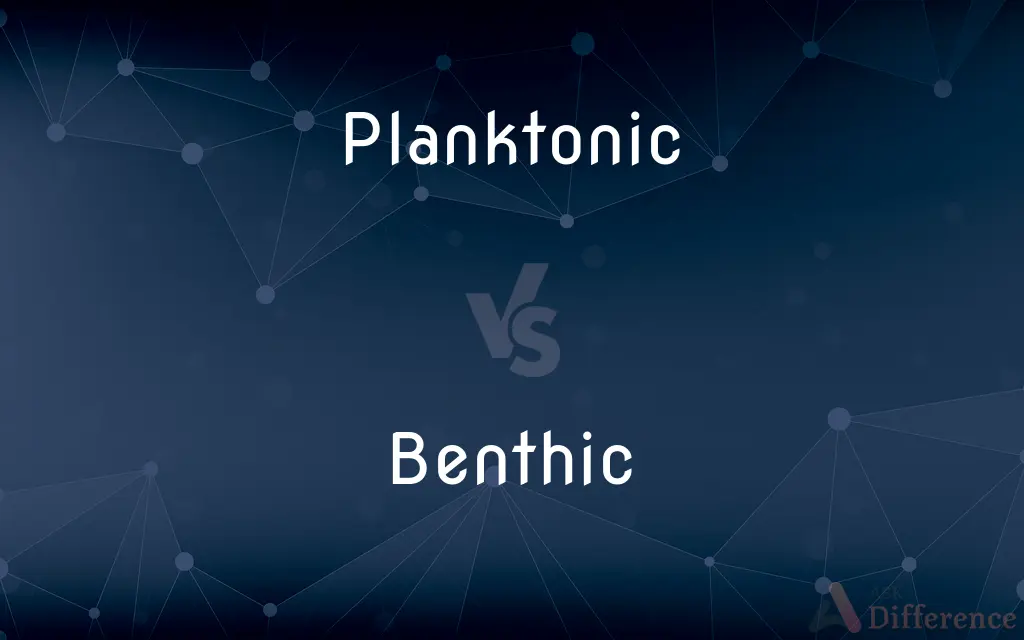Planktonic vs. Benthic — What's the Difference?
Edited by Tayyaba Rehman — By Urooj Arif — Updated on April 8, 2024
Planktonic organisms drift or float in water, living in the water column, while benthic organisms are associated with the bottom of bodies of water.

Difference Between Planktonic and Benthic
Table of Contents
ADVERTISEMENT
Key Differences
Planktonic organisms are found throughout the water column, moving primarily by water currents, indicating their adaptability to open water environments. On the other hand, benthic organisms are located at the bottom of aquatic environments, including seas, lakes, and rivers, showing a strong connection to the substrate for living, feeding, and reproducing.
The size and mobility of planktonic organisms vary widely, but they generally lack the ability to swim against currents, relying on buoyancy and water movements for dispersion. Whereas benthic organisms can range from microscopic to large sizes and often exhibit adaptations for clinging, burrowing, or crawling on the bottom surfaces.
Planktonic life stages are crucial for many marine and freshwater species, serving as a primary source of food for larger animals and playing a significant role in aquatic food webs. Benthic organisms, in contrast, contribute to the ecosystem by breaking down dead material, recycling nutrients, and serving as food for other species, including fish and birds.
Reproduction strategies among planktonic species often involve releasing eggs and sperm into the water to increase the likelihood of fertilization, capitalizing on their suspension in the water column. Conversely, many benthic species have developed specialized reproductive behaviors, such as laying eggs in protected nests or attaching them to the substrate, to enhance offspring survival.
Planktonic communities are highly sensitive to changes in water quality and temperature, serving as indicators of ecological health and shifts in environmental conditions. Benthic communities, while also affected by environmental changes, can provide a more stable indicator of long-term ecological health due to their attachment to the bottom substrates and slower population dynamics.
ADVERTISEMENT
Comparison Chart
Location
Water column
Bottom of water bodies
Mobility
Drift or float, limited self-movement
Often attached, burrowing, or crawling
Role in Ecosystem
Primary producers/consumers
Decomposers, nutrient recyclers
Reproduction
Often release gametes into water
May lay eggs in nests or attach to substrate
Sensitivity
Indicator of water quality changes
Indicator of long-term ecological health
Compare with Definitions
Planktonic
Drifters, unable to swim against currents.
Jellyfish larvae are planktonic, drifting with ocean currents.
Benthic
Essential for breaking down dead matter.
Benthic bacteria decompose organic material, cleaning water.
Planktonic
Floating organisms in water.
Planktonic algae provide crucial oxygen and food in aquatic ecosystems.
Benthic
Organisms living on or in the bottom substrate.
Benthic worms recycle nutrients on the ocean floor.
Planktonic
Vital for aquatic food webs.
Planktonic microorganisms are eaten by fish and whales.
Benthic
Includes both mobile and stationary species.
Crabs are mobile benthic animals, while corals are stationary.
Planktonic
Sensitive to environmental changes.
Planktonic species decline indicates water quality issues.
Benthic
Can be used to assess long-term ecological health.
Changes in benthic community compositions signal habitat shifts.
Planktonic
Includes both phytoplankton and zooplankton.
Phytoplankton are planktonic plants, whereas zooplankton are animal plankton.
Benthic
Adapted to various bottom environments.
Benthic creatures in deep sea vents thrive in extreme conditions.
Planktonic
The small or microscopic organisms that drift or swim weakly in a body of water, including bacteria, diatoms, jellyfish, and various larvae. Plankton is an important food source for fish and other larger organisms.
Benthic
The collection of organisms living on or in the bottom of a body of water.
Planktonic
Of or pertaining to plankton.
Benthic
The bottom of a body of water.
Planktonic
Floating in the open sea rather than living on the seafloor.
Benthic
Pertaining to the benthos; living on the seafloor, as opposed to floating in the ocean.
Planktonic
Of or relating to plankton
Benthic
Any organism that lives on the seafloor
Benthic
Of, pertaining to, or occurring at the bottom of a body of water, especially referring to the ocean depths.
Benthic
Of or relating to or happening on the bottom under a body of water
Common Curiosities
What adaptations do benthic organisms have?
Benthic organisms have adaptations like clinging, burrowing, or crawling on the bottom.
Why are planktonic organisms important?
They are crucial for the aquatic food web, serving as a primary food source for many marine species.
What defines benthic organisms?
Benthic organisms live on, in, or near the bottom of water bodies, including the sea, lakes, and rivers.
How do benthic organisms contribute to the ecosystem?
They help in nutrient recycling, breaking down dead material, and serving as a food source for other species.
What is the significance of benthic organisms in ecological studies?
Benthic organisms can indicate long-term ecological changes due to their stable population dynamics.
How do benthic organisms reproduce?
They may have specialized behaviors like laying eggs in nests or attaching them to the substrate.
What are planktonic organisms?
Planktonic organisms are small organisms that float or drift in water, including both phytoplankton and zooplankton.
How do planktonic organisms move?
They primarily move with water currents, having limited ability to swim against them.
Do planktonic organisms have a role in reproduction?
Many marine species have planktonic life stages for dispersal and increase fertilization success.
Can planktonic organisms be used as environmental indicators?
Yes, their sensitivity to water quality and temperature makes them good indicators of ecological health.
What impacts do environmental changes have on planktonic communities?
Changes can significantly affect their population, indicating shifts in water quality.
Are benthic communities affected by environmental changes?
Yes, but their response may provide a more stable indication of ecological health over time.
Share Your Discovery

Previous Comparison
Auditory vs. Auditive
Next Comparison
Connect vs. InterconnectAuthor Spotlight
Written by
Urooj ArifUrooj is a skilled content writer at Ask Difference, known for her exceptional ability to simplify complex topics into engaging and informative content. With a passion for research and a flair for clear, concise writing, she consistently delivers articles that resonate with our diverse audience.
Edited by
Tayyaba RehmanTayyaba Rehman is a distinguished writer, currently serving as a primary contributor to askdifference.com. As a researcher in semantics and etymology, Tayyaba's passion for the complexity of languages and their distinctions has found a perfect home on the platform. Tayyaba delves into the intricacies of language, distinguishing between commonly confused words and phrases, thereby providing clarity for readers worldwide.














































